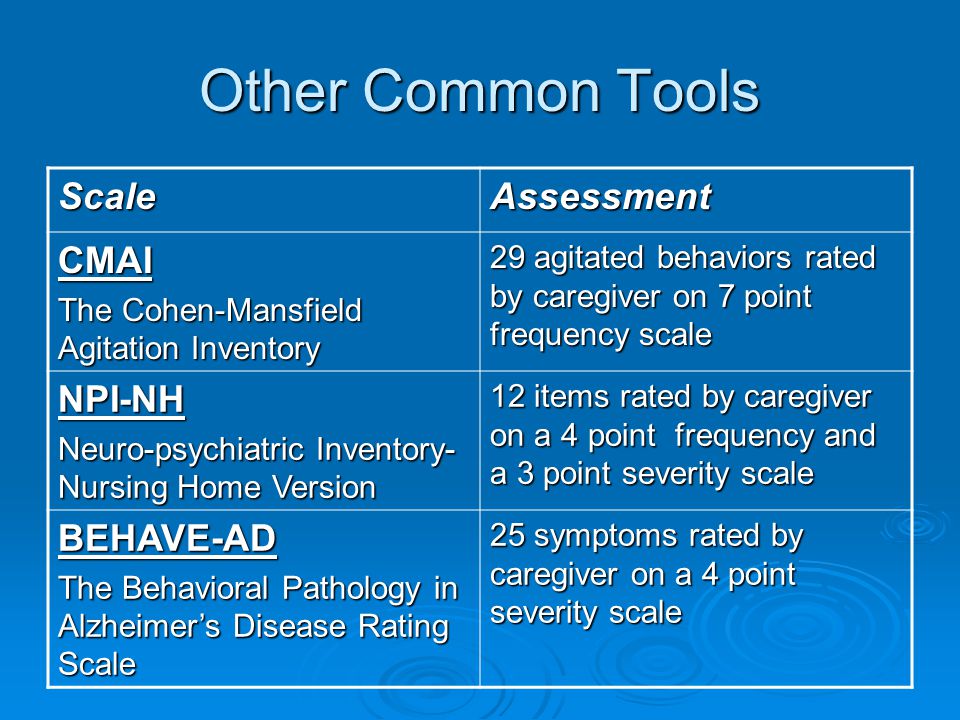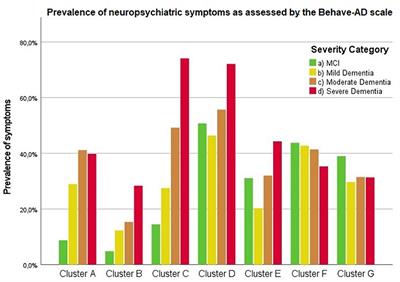behave ad scale
The scale was developed to assess common behavioural symptomatology associated with Alzheimers disease. The interrater reliability of the Behavior Pathology in Alzheimers Disease Rating Scale BEHAVE-AD a psychiatric rating scale especially designed for the evaluation of behavioral disturbances in dementia patients was studied in both English-speaking US patients and a French-speaking elderly patient population from France.

Pdf A New Behavioural Assessment Tool For Patients With Major Neurocognitve Disorders Results Of A Clinical Study Semantic Scholar
Follow us on Twitter.

. The traditional BEHAVE-AD is a severity scale without a frequency-weighted dimension 1. The BEHAVE-AD is a global measure of BPSD with 25 items grouped into seven major categories. BEHAVE-AD consists of a 25-item scale with seven categories.
And anxieties and phobias. However the incidence study did not take the severity of the symptomatology or the frequency of occurrence into consideration only the presence or absence of. The BEHAVE-AD Spanish version offers the possibility to use a screening tool for the detection of neuropsychiatric symptoms in dementia patients also applicable to nursing home residents administered by an expert clinician.
The BEHAVEAD is the original behaviour rating scale in Alzheimers disease. Become a fan on Facebook. It is in two parts.
SAGE Self Administered Gerocognitive Exam Detect early signs of cognitive memory or thinking impairmentsAccurately identify early symptoms of Alzheimers and dementia 10-15 min. To measure behavioral and psychological symptoms of dementia in patients with Alzheimers disease AD Therapeutic area Mental Disorders Nervous System Diseases Therapeutic indications Alzheimer Disease Type of Clinical Outcome Assessment COA ClinRO ObsRO Original language s English for the USA Translations 22 translation s. This scale assesses 25 characteristic potentially remediable behavioral and psychological symptoms individually on a 4-point severity scale in AD persons.
Each category is scored on a 4-point scale where 0 not present 1 present 2 present with an emotional component 3 present with an emotional. Paranoid and delusional ideation. Paranoid and delusional ideation hallucinations activity disturbance aggressiveness diurnal rhythm disturbances affective disturbances and anxieties and phobias.
INTRODUCTION The Behavioral Pathology in Alzheimers Disease Rating Scale BEHAVE-AD is a screening instrument for the evaluation of. Behavioral pathology in Alzheimers disease BEHAVE-AD rating scale. It can detect clinically significant changes in BPSD and has become widely adopted for drug trials.
Within these 6 psychological dimensions the E-BEHAVE-AD assesses 12. In this investigation the BEHAVE-AD-FW scale was administered to caregivers of 28 patients with either mildly impaired cognitive function or a dementia diagnosis. Low-Dose Risperidone Is Effective Well Tolerated in Dementia Patients.
Two clinicians separately and independently rated the responses. We found that only behavioral symptoms were associated with. AD8 Ascertain Dementia 8 Item questionnaire Brief screening for early dementia 5-10 min.
The informant-based BEHAVE-AD symptomatic category which is not assessed with the E-BEHAVE-AD is Diurnal Rhythm Disturbances BEHAVE-AD category E since it is not possible to directly observe this symptom during the brief direct observational time frame of the E-BEHAVE-AD assessment. Brief screening for early dementia 5-10 min. In particular we review the informant-based Behavioral Pathology in Alzheimers Disease Rating Scale BEHAVE-AD the related potentially more sensitive BEHAVE-AD Frequency-Weighted Severity Scale BEHAVE-AD-FW and the direct subject evaluation-based Empirical BEHAVE-AD Rating Scale E-BEHAVE-AD.
Clinical improvement defined as a 30 or greater reduction in scores on the Behavior Pathology in Alzheimers Disease Rating Scale BEHAVE-AD was seen in 54 of patients in the risperidone group 63 in the haloperidol group and 47 in the placebo group. Analyses determined that the intraclass correlation coefficients ICCs for the frequency component varied between 086 and 097 for. The kinds of medications that alleviate.
The first part concentrates on symptomatology and the second requires a global rating of the symptoms on a four-point scale of severity. Before the development of the Behavioral Pathology in Alzheimers Disease BEHAVE-AD rating scale in 1987 by Reisberg and colleagues and its predecessor scale the Symptoms of Psychosis in Alzheimers Disease SPAD rating scale in 1985 by Reisberg and Ferris other scales were available for measuring behavioral disturbances and psychiatric. This chapter is a comprehensive reference manual providing information on the Behavioral Pathology in Alzheimers Disease Rating Scale BEHAVE-AD which is a clinician rating scale based on information provided by informants.
BPSD was assessed using the Behavioral Pathology in Alzheimers Disease Frequency Weighted Severity Scale BEHAVE-AD-FW for behavioral symptoms and psychological symptoms separately and cognitive function was also assessed using the Cognitive Abilities Screening Instrument CASI. Finally in 1987 a rating scale for the assessment of potentially remediable behavioral and psychological symptoms in AD and the disturbances associated with the symptoms was published.

Addition Of A Frequency Weighted Score To The Behavioral Pathology In Alzheimer S Disease Rating Scale The Behave Ad Fw Methodology And Reliability Sciencedirect

Behavior And Personality Disturbances Clinical Gate

Behave Ad Scores By Degree Of Cognitive Impairment 95 Ci Download Scientific Diagram

Addition Of A Frequency Weighted Score To The Behavioral Pathology In Alzheimer S Disease Rating Scale The Behave Ad Fw Methodology And Reliability Sciencedirect

The Behave Ad Assessment System A Perspective A Commentary On New Findings And A Historical Review Semantic Scholar

Approaches To Behavioral And Psychological Symptoms Of Dementia Ppt Video Online Download

Addition Of A Frequency Weighted Score To The Behavioral Pathology In Alzheimer S Disease Rating Scale The Behave Ad Fw Methodology And Reliability Sciencedirect

The Behave Ad Assessment System A Perspective A Commentary On New Findings And A Historical Review Semantic Scholar

Table 3 From The Behave Ad Assessment System A Perspective A Commentary On New Findings And A Historical Review Semantic Scholar

Behavior Rating Scale An Overview Sciencedirect Topics

The Dr Ian Dunbar Aggression Assessment Scale Modified By Dr Dunbar Download Scientific Diagram

Behavioral And Psychological Symptoms Of Dementia Part I Epidemiology Neurobiology Heritability And Evaluation Consultant360

Common Scales Used For Measuring The Behavioral Manifestations Of Dementia Download Table

Frontiers Neuropsychiatric Symptoms In Mild Cognitive Impairment And Dementia Due To Ad Relation With Disease Stage And Cognitive Deficits Psychiatry

Addition Of A Frequency Weighted Score To The Behavioral Pathology In Alzheimer S Disease Rating Scale The Behave Ad Fw Methodology And Reliability Sciencedirect

Practical Guidelines For The Recognition And Diagnosis Of Dementia American Board Of Family Medicine

Pdf The Empirical Behavioral Pathology In Alzheimer S Disease E Behave Ad Rating Scale

Addition Of A Frequency Weighted Score To The Behavioral Pathology In Alzheimer S Disease Rating Scale The Behave Ad Fw Methodology And Reliability Sciencedirect

Addition Of A Frequency Weighted Score To The Behavioral Pathology In Alzheimer S Disease Rating Scale The Behave Ad Fw Methodology And Reliability Sciencedirect
Comments
Post a Comment